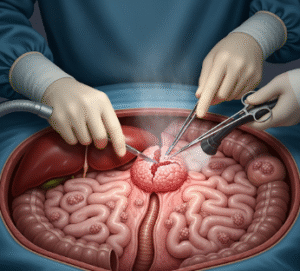Overview
Visceral pain is pain that arises from the internal organs (viscera), such as the stomach, intestines, liver, pancreas, bladder, or uterus. Unlike somatic pain, which is sharp and localized, visceral pain is often diffuse, deep, and difficult to pinpoint, sometimes radiating to other areas of the body.
➤ Visceral pain can result from inflammation, distension, ischemia, obstruction, or organ dysfunction.
➤ It is a common symptom in conditions like gastrointestinal disorders, urinary tract problems, and gynecological issues.
➤ In Korea, hospitals provide diagnostic evaluation, medical therapy, minimally invasive procedures, and advanced pain management for visceral pain.
Key Facts
► Definition: Pain originating from internal organs, typically diffuse and poorly localized.
► Prevalence: Common in adults with gastrointestinal, urinary, or reproductive system disorders.
► Associated symptoms: Nausea, vomiting, bloating, cramping, sweating, or referred pain.
► Risk factors: Chronic medical conditions, organ inflammation, obstruction, infection, or ischemia.
► Treatment in Korea: Medications, nerve blocks, minimally invasive procedures, and lifestyle management.
What Is Visceral Pain?
Visceral pain is transmitted via autonomic nerves and is often associated with referred pain in areas such as the back, shoulders, or chest.
➔ It usually involves slow-conducting C fibers, which explain why the pain is dull, aching, or cramping rather than sharp.
➔ Visceral pain may trigger autonomic responses like sweating, nausea, vomiting, or changes in heart rate and blood pressure.
➔ Understanding the origin and characteristics of visceral pain is essential for effective treatment.
What Symptoms Are Related to Visceral Pain?
Symptoms depend on the affected organ and severity:
→ Dull, aching, or cramping pain in the abdomen, chest, or pelvis.
→ Referred pain to areas like the shoulder, back, or groin.
→ Nausea and vomiting, often accompanying gastrointestinal or hepatobiliary pain.
→ Sweating, pallor, or rapid heartbeat due to autonomic responses.
→ Bloating, distension, or urinary changes if digestive or urinary organs are involved.
→ Discomfort during physical activity or at rest, varying with organ involvement.
Causes / Possible Causes of Visceral Pain
Gastrointestinal Causes
➤ Gastritis or peptic ulcers – Inflammation of the stomach lining causes upper abdominal pain.
➤ Irritable bowel syndrome (IBS) – Functional disorder causing recurrent abdominal cramping and discomfort.
➤ Gallstones or cholecystitis – Pain in the right upper quadrant, often radiating to the back or shoulder.
➤ Pancreatitis – Severe upper abdominal pain radiating to the back.
Urinary and Renal Causes
➔ Kidney stones (nephrolithiasis) – Sharp, cramping pain in the flank radiating to the groin.
➔ Urinary tract infections (UTIs) – Painful bladder or lower abdominal discomfort.
Gynecological Causes
→ Endometriosis – Chronic pelvic pain, often associated with menstruation.
→ Ovarian cysts or torsion – Acute, severe lower abdominal or pelvic pain.
→ Pelvic inflammatory disease (PID) – Diffuse pelvic pain with fever and discharge.
Cardiovascular and Other Causes
► Myocardial ischemia – Sometimes manifests as upper abdominal or epigastric pain.
► Mesenteric ischemia – Severe abdominal pain due to reduced blood flow to the intestines.
► Abdominal aortic aneurysm – Sudden, severe pain with possible radiating back pain.
When Should I See My Doctor?
Seek medical attention if visceral pain:
➤ Is sudden, severe, or worsening.
➤ Is accompanied by vomiting, fever, blood in stool or urine, or jaundice.
➤ Causes difficulty breathing, chest pain, or fainting.
➤ Persists despite home measures and over-the-counter pain relief.
➤ Early evaluation is critical to prevent organ damage, obstruction, infection, or life-threatening conditions.
Care and Treatment
Lifestyle and Home Measures
► Maintain hydration and a balanced diet to support digestive and urinary health.
► Avoid alcohol, smoking, or irritant foods that exacerbate gastrointestinal pain.
► Practice stress management and regular physical activity to improve overall well-being.
► Track pain patterns to help diagnose underlying conditions.
Medical Treatments
➔ Analgesics such as acetaminophen or NSAIDs for mild pain relief.
➔ Antispasmodics for gastrointestinal cramping or IBS.
➔ Antibiotics for infections like UTIs or PID.
➔ Hormonal therapy for gynecological causes such as endometriosis.
➔ Medications for reflux, ulcers, or pancreatitis as indicated by diagnosis.
Procedural and Advanced Interventions
→ Nerve blocks or epidural analgesia for severe, chronic visceral pain.
→ Minimally invasive procedures such as laparoscopic surgery for gallstones, ovarian cysts, or appendicitis.
→ Endoscopic interventions for gastrointestinal obstructions or ulcers.
→ Multidisciplinary pain management programs integrating medical, surgical, and rehabilitative care.
Treatment Options in Korea
Korean hospitals provide comprehensive care for visceral pain:
Diagnosis in Korea
➤ Laboratory tests to identify infection, inflammation, or organ dysfunction.
➤ Imaging studies like ultrasound, CT scan, MRI, or endoscopy to pinpoint the source.
➤ Gynecological evaluation for pelvic pain in women.
➤ Cardiovascular assessment for referred pain from ischemia.
Non-Surgical Care
► Medications tailored to the underlying condition (pain relief, antibiotics, antispasmodics, or hormonal therapy).
► Lifestyle counseling for dietary modifications, stress management, and exercise.
► Physical therapy for chronic pelvic or abdominal pain.
Advanced and Surgical Care
➔ Laparoscopic or endoscopic procedures for gallstones, appendicitis, or ovarian cysts.
➔ Interventional radiology for vascular causes or abdominal ischemia.
➔ Multidisciplinary approach combining gastroenterology, urology, gynecology, and pain management.
Rehabilitation and Lifestyle Support
→ Monitoring and follow-up for chronic visceral pain conditions.
→ Education on preventive measures, dietary habits, and exercise.
→ Long-term management for patients with recurring or complex pain syndromes.
Korean hospitals combine expert multidisciplinary teams, advanced diagnostics, and patient-centered care, ensuring effective management of visceral pain and improved quality of life.













